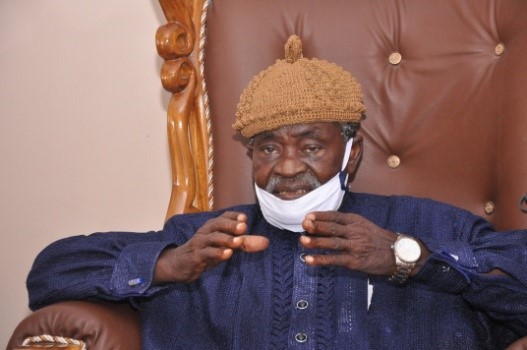
Ikot Abasi Local Government Area in Nigeria’s southern state of Akwa Ibom, plays host to arguably the richest relics of the trans-atlantic slave trade and colonial history in Nigeria.
Ikot Abasi has an estimated population of 132,023, according to the 2006 national census. It is under the political administration of Hon. David David Eshiet, who was elected in 2017. Traditionally, Ikot Abasi is administered by His Royal Majesty, Edidem Udo Joe Ntuk Obom.
Ikot Abasi was part of the ancient Opobo Kingdom until the 1970s when a boundary readjustment led to a split. According to famous online encyclopedia, Wikipedia, Opobo Island was made part of Rivers State while the mainland part remained within Cross River. The mainland part, renamed Ikot Abasi, now lies in present-day Akwa Ibom State.
From the 16th century till few months to start of the first World War in 1914 when slave trade in West Africa officially ended, over a million Africans were ferried to the Western world through the Ikot Abasi coast which is one of the deepest shorelines in all of Africa. The coast was ideal for giant slave ships from Europe and America.
Ikot Abasi was also a major route for transportation of items like palm oil and artifacts to the faraway land of the whites.
Today, decaying relics of slave trade and colonialism offer a peep into a history that has become a scar for humanity.
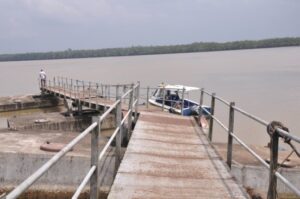
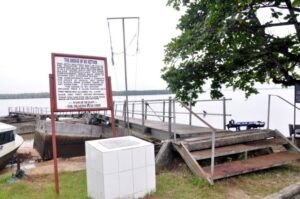
*The Bridge of No Return
Located on the bank of the Ikot Abasi sea is a floating bridge originally constructed in 1795. Slaves bounded in chains were forced down the bridge before being loaded on to awaiting ships to Europe and America. Once a slave walks past it, there was no chance of returning, hence the name: ‘The Bridge Of No Return.’
Made of corrugated iron and steel, the bridge has a fulcrum (no longer functioning) midway through it which made it move in tandem with sea waves. The sea cannot however sweep off the bridge because it is heavily studded and anchored by giant concretes.
It has three underground concrete bunkers where stubborn slaves were kept before being whisked away to Europe and America.
The original bridge, having undergone centuries of dilapidation, was replaced in 2014. The project was facilitated by Hon. Akpan Micah Umoh, who represented Ikot Abasi Federal Constituency in Nigeria’s House of Representatives from 2011 to 2015.
The new bridge has however suffered alarming deterioration. The corrugated iron and steel are ravaged by rust. Treading the bridge is not a task for the fainthearted due to its unstable and weak condition.

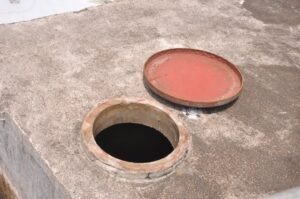
*The Slaves’ Warehouses and Scale
Adjacent to the bridge is an ancient bungalow which served as warehouse for the slaves. Captured slaves were kept there prior to being sold by dealers to traders in Europe and America. The rotting edifice is now occupied by persons who pay rent to the local authorities.
Inside the building lie iron beds used by the slave dealers and masters. There is also a measurement scale which was used to determine whether slaves met certain specifications required by prospective buyers.
Another warehouse for slaves, John Miller House, is located on the river bank. John Miller was a famous slave master. The two-storey edifice, built majorly with hard wood, consists of 15 rooms. A beacon stone shows that the edifice was erected in 1834.
By this time, the treaty ending the slave trade had already been signed and enforced. While the British signed the treaty in 1807, the United States had theirs done in 1808.
Occupying the edifice are two families headed by Mr. Ufot Emmanuel Akpan, a 68-year-old father of six, and Mr. Etim Udo Innemeh, a father of eight, who said he has lived there for 30 years.
Inspecting the facility, the level of deterioration was discovered to be horrible.
Mr. Innemeh and Mr. Akpan appealed to the Akwa Ibom State Government to rescue the building from possible collapse.
“I have lived here since 1990. It is 30 years since I moved into this property on 15th January, 1990. There are no social amenities here, and as you can see, the building itself is not in good condition. People have been coming here to look at the building. I appeal to the state government to mitigate the deterioration of this building”, Innemeh stated in Annang dialect.
Inemeh disclosed that he pays N500 monthly as rent on the property to the local authorities.
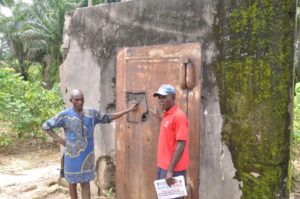
*The British Slave Bank
On another flank of the river are the remains of the British Slave Bank. The most notable remains of the bank are its giant safe which has survived centuries of attempts to break it open. Funds -mostly coins- used in the slave business were stored there by the slave dealers.
According to residents of the area, a section of slaves once revolted and surprisingly overpowered the dealers. In the ensuing rumpus, a white employee of the bank was chased by the locals.
He is said to have run to the bank and locked himself inside the safe. The safe has remained shut ever since. Efforts to open it using dynamites and other tools have not been successful.
*The Rail Tracks and Palm Oil Business
Apart from slaves, palm oil and other agricultural commodities were also ferried to the Western world from present day Ikot Abasi. The commodities were ferried through water and land. On land, trains were used. Relics of the rail track are just a stone throw from the coast.
*King Jaja of Opobo Versus the British
Born Jubo Jubogha in 1821, King Jaja was the founder of the ancient Opobo State. He was sold as a slave in Bonny in present day Rivers State at the age of 12. He worked his way out of slavery in Bonny and rose to head the Anna Pepple House of Bonny Island where he was serving as a slave.
A trade dispute made Jaja break away to establish the Opobo City State, 26 miles east of Bonny in 1869.
Much to the chagrin of the whites, Opobo dominated the region’s palm oil trade. The king blocked the British merchants and made Opobo ship palm oil directly to Britain.
According to available records including Wikipedia, “at the 1884 Berlin Conference, the Europeans officially designated Opobo as British territory.
Henry Hamilton Johnston, a British vice consul, invited Jaja for negotiations. Jaja was arrested on arrival aboard a British vessel. He was tried in Accra in the Gold Coast (now Ghana) then exiled to London and then Saint Vincent in the West Indies and Barbados.
In 1891, Jaja was granted permission to return to Opobo, but died en route. Following his exile and death, the power of the Opobo State rapidly declined.
The eventual demise of King Jaja and decline of Opobo was a huge dent to Africans’ resistance and strengthened the West’s imperialism. Similar occurrences in other parts of present day Nigeria and Africa paved the way for colonial rule.
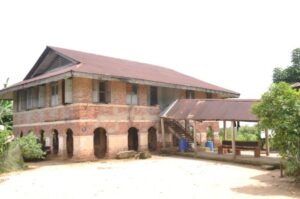
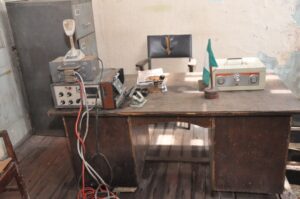
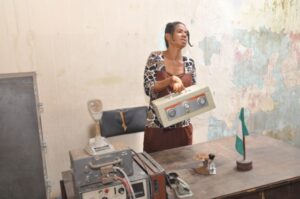

*Ikot Abasi, Lord Lugard, Amalgamation and Colonial Rule
Slave trade in West Africa finally ended just before the start of the World War 1 in 1914. Same 1914, January 1 precisely, Lord Frederick Lugard became the governor of the Colony of Nigeria made up of the Northern and Southern Protectorates. A document was signed officially creating the Colony and Protectorate of Nigeria.
The amalgamation document was signed in ancient Opobo in today’s Ikot Abasi. The Amalgamation House, made of hard wood, still stands. Lugard’s office where the document was signed was intact when our correspondents visited. Equipment like the alarm cash box, his official chair/table, telephone, radio receiver and official portraits were on display.
Conducting correspondents round the facility, the tour receptionist, Mrs. Cyrilla Effiong Bassey, said the house has over the years been visited by many from within Nigeria and overseas, but nothing has been done to address the decay.
“People come here on a daily basis from home and abroad. People from USA, Japan, UNESCO came, even World Bank and many government agencies. These visitors always express their determination to partner the state government to put the place in shape”, she explained.
She has served as a volunteer receptionist at the facility for nine years. Bassey, who said she was recruited by the Federal Government under the War Against Indiscipline (WAI) programme controlled by the National Orientation Agency, revealed that the edifice was assigned as office for the programme.
The house where Lord Lugard lived, a two-storey building, stands opposite the Amalgamation House. The concrete house is currently occupied by tenants.
*Paramount Ruler seeks Government’s Action
Edidem Udo Joe Ntuk Obom, paramount ruler of Ikot Abasi, has called on the Federal Government and the Akwa Ibom State Government to preserve the sites for tourism and posterity.
Speaking to our correspondents in his palace, the monarch explained how government can intervene: “It is not necessarily about re-roofing the place. Modernizing it will take the ancient colouration away. We want to preserve and protect their originality so they can be there for tourists’ attraction. That is what it should be.”
“Government has not done anything – both the federal and state governments have done nothing. Lord Lugard’s house should be a monument for people to study and get to know about him. The sites are still there till tomorrow but it continues to decay and dilapidate because no efforts have been made to keep them in good shape”, the monarch added.
He said that contrary to claims in some quarters that the Amalgamation Treaty was signed in Lokoja, Kogi State, it was actually done in Ikot Abasi at the Amalgamation House.




